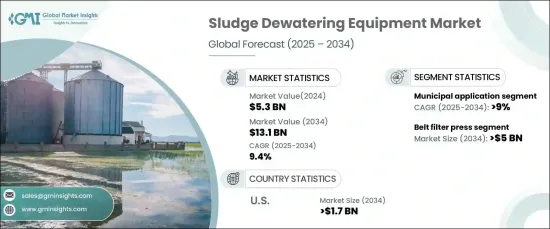
세계의 슬러지 탈수 장비 시장은 2024년 53억 달러에 이르렀고, 2025년부터 2034년까지 연평균 복합 성장률(CAGR) 9.4%로 확대될 것으로 예상됩니다.
이 성장에는 도시화, 산업 활동 증가, 폐수 관리를 중시하는 환경 규제 강화가 박차를 가하고 있습니다. 치료 플랜트에서 배출되는 슬러지의 양이 증가하는 과정을 거치면서 처리 비용과 환경 위험을 줄이기 위한 효율적인 탈수 솔루션에 대한 수요가 증가하고 있습니다.

슬러지 탈수 기술의 진보는 시장 환경을 현저하게 향상시키고 있습니다. 최신 장치는 효율성과 신뢰성을 향상시키기 위해 설계되었으며 비용 효율적이고 지속 가능한 솔루션에 대한 요구가 높아졌습니다. 탈수 공정에서의 IoT 대응 자동화의 채용은 기세를 늘리고 있으며, 실시간 감시와 보다 나은 운전 제어를 제공함으로써 자원 이용 최적화와 정확한 관리로 이어지고 있습니다.
| 시장 범위 | |
|---|---|
| 시작 연도 | 2024년 |
| 예측 연도 | 2025-2034년 |
| 시작 금액 | 53억 달러 |
| 예측 금액 | 131억 달러 |
| CAGR | 9.4% |
다양한 기술 중에서도 많은 양의 슬러지를 효율적으로 처리할 수 있는 기계 시스템은 많은 산업에서 선호되는 옵션으로 부상하고 있습니다. 이러한 시스템은 운영 효율성과 폐기물 관리 프로세스의 간소화 능력으로 알려져 있습니다. 미처리 폐기물을 다루는 규제적 의무와 매립지 부족으로 혁신적인 탈수장치에 대한 수요가 더욱 높아지고 있습니다.
지자체 부문은 2034년까지 연평균 복합 성장률(CAGR)이 9%를 초과할 것으로 예상되고 있으며, 시장 확대 추진에 있어 매우 중요한 역할을 할 것으로 예상됩니다. 폐기물 처리 인프라에 대한 투자 증가와 환경 영향을 최소화하기 위한 규정 준수 기준의 엄격화는 지자체 응용 분야에서 탈수 장치를 채택하는 것을 뒷받침하고 있습니다. 급속한 산업화와 미처리 폐수 배출에 대한 노력도 시장 성장에 기여하고 있습니다. 또한 산업 시설에 통합된 새로운 폐수 처리 장치는 규제 요건을 충족하기 위해 이러한 기술의 채택을 뒷받침하고 있습니다.
미국에서는 슬러지 탈수 장비 시장이 2034년까지 17억 달러 이상에 달할 것으로 예측됩니다. 규제 압력 증가와 지속 가능한 폐기물 관리 솔루션의 필요성은 산업 부문과 지자체 부문 모두에서 큰 수요를 이끌고 있습니다. 매립지에 대한 의존도를 줄이고 자원 회수를 개선하려는 움직임이 첨단 탈수 기술의 채택을 가속화하고 있습니다. 게다가 노후화된 폐수 인프라의 업그레이드와 처리 능력의 확대가 시장 개발을 더욱 뒷받침하고 있습니다.
The Global Sludge Dewatering Equipment Market reached USD 5.3 billion in 2024 and is expected to expand at a CAGR of 9.4% between 2025 and 2034. This growth is fueled by increasing urbanization, industrial activities, and stricter environmental regulations emphasizing wastewater management. As the volume of sludge from treatment plants continues to rise, the demand for efficient dewatering solutions to downsize disposal expenses and environmental risks is intensifying.

Advancements in sludge dewatering technologies are significantly enhancing the market landscape. Modern equipment is designed for improved efficiency and reliability, aligning with the growing need for cost-effective and sustainable solutions. The adoption of IoT-enabled automation in dewatering processes is gaining momentum, providing real-time monitoring and better operational control, which leads to optimized resource utilization and precision management.
| Market Scope | |
|---|---|
| Start Year | 2024 |
| Forecast Year | 2025-2034 |
| Start Value | $5.3 Billion |
| Forecast Value | $13.1 Billion |
| CAGR | 9.4% |
Among various technologies, mechanical systems are emerging as the preferred choice for many industries due to their ability to handle large volumes of sludge efficiently. These systems are known for their operational effectiveness and the capability to streamline waste management processes. Regulatory mandates addressing untreated waste and the scarcity of landfill space further amplify the demand for innovative dewatering equipment.
The municipal sector is projected to play a pivotal role in driving market expansion, with an expected CAGR exceeding 9% through 2034. Increasing investments in waste treatment infrastructure, combined with stricter compliance standards for minimizing environmental impact, are propelling the adoption of dewatering equipment in municipal applications. Rapid industrialization and efforts to address untreated wastewater discharges also contribute to market growth. Furthermore, new wastewater treatment units integrated within industrial facilities are boosting the adoption of these technologies to meet regulatory requirements.
In the U.S., the sludge dewatering equipment market is forecasted to surpass USD 1.7 billion by 2034. Growing regulatory pressures and the need for sustainable waste management solutions are driving significant demand in both industrial and municipal sectors. The push for reducing landfill dependency and improving resource recovery has accelerated the adoption of advanced dewatering technologies. Additionally, upgrades to aging wastewater infrastructure and expansion of treatment capacity are further supporting market development.